They called them “women’s pictures” at the studios, but to the world at large they were soaps or soap operas—a term derived from the fact that radio dramas of this kind were almost invariably sponsored by soap manufacturers on the theory that women were the market for soap products. They were also called “tearjerkers,” “weepies,” and “three-handkerchief pictures.” (Sometimes handkerchief was abbreviated, but for personal reasons, I won’t go into that.) By whatever name, movies of this sort were in theory designed to appeal to a female audience. In essence, they’re the logical ancestor of the so-called “chick flick”—or are they?
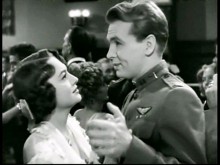
Ever since I watched Mitchell Leisen’s To Each His Own (1946) the other morning, I’ve been thinking about this much-maligned genre and my personal relationship with it. Back when I was working my way into movies through that most common medium for my generation, television, there wasn’t much in the way of a guide apart from TV Guide. People didn’t write much about movies—certainly not older movies. That left you with the possibility of someone telling you about a movie or just reading the information in TV Guide—both pretty perilous propositions.
Back then, TV Guide mostly broke movies down into the following genres: drama, comedy, musical, fantasy, science-fiction, mystery and melodrama. You’ll immediately notice the lack of a horror category. For some inexplicable reason, all horror pictures were melodramas. In fact, I don’t recall anything else being called “melodrama.” Beyond that, you got a few star names and a Twitter-length plot synopsis that was rarely enlightening and often just plain wrong. (I still recall the synopsis for a British cheapie starring Arthur “The Street Singer” Tracy called Command Performance [1937] that claimed Tracy played a singer disfigured in a fire, which had nothing whatever to do with the movie.)
By far the biggest dumping ground was the drama. Anything that didn’t fit elsewhere was a drama—and to my youthful mind that meant it was probably going to be boring. My notion of what constituted a drama was was Robert Wise’s Executive Suite (1954), which bored me to death around the age of 12 (I’m not exactly keen on it now, come to that). So I steered clear of those out of a keen sense that I wouldn’t like them. This means I didn’t see anything that could qualify as a soap—exempting my mother’s short-lived addiction to TV soaps like As the World Turns and The Edge of Night, which ended when I was about six—for some considerable time.
This changed when I made friends with a kid my own age (13) whose tastes were unusual to say the least. Oh, he liked horror movies well enough and mysteries and comedies and some musicals. His big interests were Doris Day (dear Lord), the Perry Mason TV show, Julia Child’s The French Chef and, for whatever reason, Charles Boyer. I have no idea where he came up with Boyer, though my suspicion is the TV series The Rogues, but that’s mostly because that’s all I knew Boyer from at the time. Regardless, he convinced me to watch John M. Stahl’s When Tomorrow Comes (1939) on the late show. Could there possibly be a soapier title than When Tomorrow Comes? And it was certainly soap.
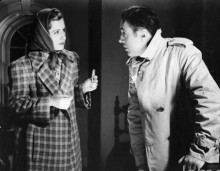
A story about a concert pianist (Boyer) who falls in love with a waitress is one thing. When the waitress is played by Irene Dunne (Irene Dunne as a waitress is kind of like casting Garbo as a car hop) it’s another. When the love of waitress and pianist can never be because he has a mentally unstable wife (Barbara O’Neil) it transforms yet again. But then when the big set piece features Boyer and Dunne trapped in the organ loft of a church while floodwaters rise around them? Well, we’re talking absurdist nirvana here. We’re talking about being able to wash your clothes, your car, your dishes, take a bath and still have suds left over. In other words, I absolutely adored this movie. And it started me on the road to liking classic soap operas.

Strangely, I have never seen When Tomorrow Comes since then. It’s simply become one of those films that has slipped through the cracks. Well, there’s no Irene Dunne or Charles Boyer cult and Stahl’s reputation has suffered because the bizarrely lionized Douglas Sirk remade three of his films—Imitation of Life (1934), Magnificent Obsession (1935) and this one (as Interlude). I’ve never understood why people are ga-ga over Sirk. His films seem like typical glossy 1950s Ross Hunter productions to me. I see no significant difference between the films Sirk directed for Hunter and those helmed by David Miller (who remade Stahl’s 1932 Back Street for Hunter in 1961) and Michael Gordon. But Sirk gets the box set and Stahl gets the shaft. His Imitation of Life comes as a double feature with Sirk’s version. Stahl’s Magnificent Obsession is an “extra” thrown in as a bonus on the DVD of the Sirk remake.
All that apart, I started seeking out films of this sort after seeing When Tomorrow Comes, and the next one to cross my path was another Stahl film, Imitation of Life, though I’m pretty sure I didn’t put this fact together at the time. (The idea of paying attention to directors hadn’t sunk in at that point.) Now, in its own way, Imitation of Life isn’t a lot less absurd than When Tomorrow Comes—at least on the surface.
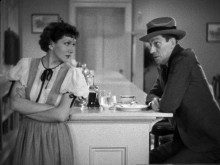
If you don’t know the film, it charts the fortunes of Bea Pullman (Claudette Colbert), a young widow who is trying to support herself and her daughter in the midst of the Depression by taking over her late traveling pancake syrup salesman husband’s accounts. When this isn’t working out so swell, she hits on the idea of opening a pancake restaurant on the Boardwalk in Atlantic City where her black maid, Delilah (Louise Beavers), will prepare her apparently irresistible pancakes. This is a success, but it’s nothing compared to what happens when Bea stakes a hungry man, Elmer Smith (Ned Sparks), to a second stack of pancakes in exchange for “a hundred thousand dollar idea,” which is summed up in two words, “Box it.” And so Aunt Delilah’s pancake mix is born and the two women become fabulously wealthy. In the midst of this Bea meets and falls in love with dashing icthyologist (I am not making this up) Steven Archer (Warren William). Unfortunately, Bea’s now grown daughter Jessie (Rochelle Hudson) falls in love with him, too, and fancies he reciprocates her affections, and so Bea has to give him up—at least until Jessie gets over her crush (or so it’s implied).
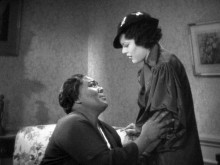
Now, I don’t care how well-written, well-acted and well-directed that is—and it is very well done on all scores—it’s still on the preposterous side. But I’ve left out the secondary plotline and that’s the one that makes the film considerably more significant. Delilah has a light-skinned daughter named Peola—so light in fact that people think she’s half white, which makes it hard for Delilah to get employment. In fact, Bea is at first uneasy on this score. (The extra prejudice over a child of mixed race is kind of a sub-subtext.)
Peola learns she can pass for white and does so at school till the day Delilah accidentally “outs” her, causing an outburst with Peola claiming she “won’t be black.” By the time Peola (now played by Fredi Washington) is old enough, she brutally disowns her mother (“Am I not white?”) and runs away, breaking Delilah’s heart and her spirit. She comes back just in time to see her mother’s funeral procession, whereupon she breaks down, throws herself on the coffin and begs her mother’s forgiveness. That may sound melodramatic in print.On the screen, it is heart-breaking and shattering.
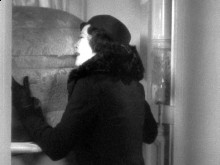
None of this takes into account the subtext of the film that constantly depicts Delilah as happy to be subservient. Even when they’re rich, she insists on living in less grand accomodations below stairs in the house “Miss Bea” buys. She has flashes of shrewdness that indicate that she’s not meant to be dumb, but she still seems to feel she “knows her place” and feels a keen racial divide. (When Peola disowns her, Delilah wails, “I’m your mammy, child. I ain’t no white mother.”) Whether this depiction of inequality is intentional or not—and it may well not be—it gives Imitation of Life an extra dimension, especially since all this wealth wouldn’t exist without Delilah’s pancake recipe.

The point I’m trying to make here is that not only can soap be entertaining, worthwhile and exquisitely moving, it can also be quite powerful and it often addressed issues that other forms of drama tended to ignore. Edna Ferber’s novel Show Boat was essential soap, as was the stage show that turned into a musical. At bottom, it’s a musical soap. And it, too, deals with racism and miscegenation in its subplot. James Whale’s 1936 film version of Show Boat really drives it home through his direction of that material. When Steve Baker (Donald Cook)—who has cut his racially-mixed wife’s (Helen Morgan) hand and swallowed some of her blood—avows he’s got “more than a drop of Negro blood” in him and underscores it by saying, “That’s how white I am,” it’s Whale’s decicision to cut to a close-shot of a shamed and saddened Paul Robeson on that line that gives it its power.
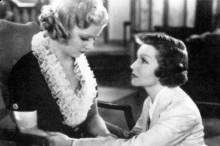
Similarly, there’s Gregory LaCava’s Private Worlds (1935), another almost completely forgotten and rarely shown film. It’s a fairly simplistic take on the material—and it’s very much a soap opera—but it is probably the first film to deal with the subject of mental illness on a serious level. Previously—and mostly subsequently—mental illness was played either for thrills (the homicidal madman) or for laughs (the genial comic lunatic). Private Worlds took the topic in a wholly different direction. So, for that matter, did Stahl’s aforementioned When Tomorrow Comes.
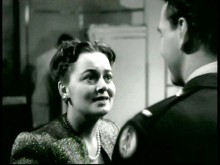
Take a look at the film that spawned this column, Mitchell Leisen’s To Each His Own. Aside from providing two hours of truly solid entertainment and filmmaking with great performances and moments of absolute beauty—and a witty screenplay—it is surprisingly blunt in its condemnation of a society that looks down on unwed mothers and illegitmate children. At no point are the morals of its heroine (Olivia DeHavilland) questioned by the film, but the fact that she has to pretend her child isn’t hers so that he won’t be ostracized as “the town bastard” (a phrase removed from the screenplay during production) is unquestionably looked at as immoral in itself.
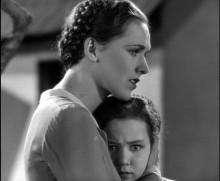
The truly funny thing about the disdain with which the soap opera is viewed isn’t just how very good a great many of them are, but the surprising number of films that aren’t lumped in with the genre, but in actual fact most certainly qualify. In terms of content, a great many of the films of Frank Borzage are clearly soap. Certainly 7th Heaven (1927), Street Angel (1928) and History Is Made at Night (1937) qualify, but we respect them too much to call them soap. Even his film version of Ferenc Molnar’s Liliom (1930) fits the bill, even if it adds fantasy and allegory to the mix. What is it at bottom, but the story of a woman (Rose Hobart) who stubbornly loves and believes in the pretty worthless title character, even though his mistreats her, batters her, and leaves her pregnant with his child when he kills himself rather than be arrested for a botched robbery. If that ain’t soap, I’m betting you could still wash up with it.
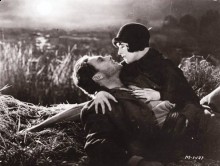
And what of F.W. Murnau’s Sunrise (1927)? We don’t call it soap. In fact, a lot of people call it the greatest movie ever made, but look at the story. Here we have a hunky, but not terribly sharp farmer (George O’Brien) who is besotted with a city woman (Margaret Livingston), who talks him into drowning his wife (Janet Gaynor). But when it comes down to it, he can’t and the bulk of the film involves them reconciling on a trip to the city, until on the way back their boat capsizes in a storm and the wife is presumed drowned—only to be found later held afloat by the reeds he’d meant to use to save himself after murdering her. Artistry and emotional honesty make it something far more than a soap opera.
The qualities of artistry and emotional honesty are the key to good soap as well. That, I think, is why I don’t admire the Douglas Sirk/Ross Hunter soaps of the 1950s. The mechanics are there, but the emotional honesty isn’t. If anything, these films are not only emotionally dishonest in their post-modern smart-assery, they feel contemptuous of both the audience and the material in their ironic detachment. They have an unpleasant undercurrent of the cynicism of putting out a product that the filmmaker feels superior to.
This is also part of the reason why the modern “chick flick”is a wholly different proposition than the classic soap. It doesn’t help that the romantic drama is all but dead. All that seems to be left are adaptations of Nicholas Sparks novels, works so sappy, stiff and just plain bad that they make the works of Edna Ferber, Fannie Hurst and Lloyd C. Douglas look like truly great literature. I suppose a truly pathetic case can be made that the Twilight series is a teenage variant on the soap, but soap operas get enough bad press without throwing that burden on them.
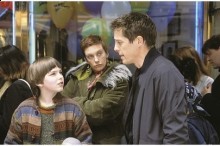
Though it’s more than a soap opera, the only English language film of recent vintage that comes to mind that has strong elements of classic soap is Chris and Paul Weitz’s About a Boy (2002). Yes, the film is more complex and layered than a soap, but some its plot devices—the suicidal mother, the redemption of the callow playboy—would hardly be out of place there. That About a Boy virtually defies genre classification makes it all the less surprising that it might incorporate elements of yet another genre. (I fervently hope that it wasn’t this non-specific genre attitude that prompted Chris Weitz to fritter away his talents making The Twilight Saga: New Moon.)

If you really want to see the modern equivalent of the classic soap you have to go to Spain and Pedro Almodovar. On the surface, Almodovar’s brightly colored fantasias with their heightened reality, bizarre and even farcical situations might seem to have more to do with the Sirkian soaps of the 50s than they do with classic soaps. That’s on the surface, though. While Almodovar does poke fun at the genre conventions of the soap opera by taking them to extreme—often unthinkable—extremes, he never approaches the resulting material as if he’s better than it. More importantly, his characters are always treated with a degree of respect, regardless of how ridiculous they might be. In that regard, he not only resembles Stahl more than Sirk, he resembles Jean Renoir more than anyone. I can think of no other filmmaker less judgmental of his characters.
So there you have some fairly random thoughts on the soap opera—and hopefully a few reasons why you might want to rethink this particular type of film, if you haven’t already. And I send out my personal thanks to the guy who got me to watch When Tomorrow Comes, wherever he is.




Ah, the lowly soap. One of my guiltiest pleasures. Even watch and FF a few of them daily. (I’m not as strong -willed as your mother. I maintain my obsessions for years).
I adore them! Not today’s “chick flick”, but the oldies. I, too, am no fan of Sirk of love Stahl and Leisen.
But how you not mention Bette Davis? “The Great Lie”, “Dark Victory” and, my unabashed favorite- “Now Voyager” among many other lesser WB lights. Fie, Mr Hanke!
I do remember the day when TV GUIDE was the bible. “Bride of Frankenstein” was listed as a melodrama when I was first aware of the joy of “horror” …and I was forevermore on the track of the melodrama. What would have the Guide made of Tod Slaughter?
But how you not mention Bette Davis? “The Great Lie”
Do I get points for including a recommendation to watch The Great Lie on TCM in last Tuesday’s “Weekly Reeler?” If I had to pick a favorite Davis soap, it’d probably be that, though I do like Deception a lot — probably mostly for the bit where Claude Rains reads the funny papers.
What would have the Guide made of Tod Slaughter?
They were still in their melodrama phase when I saw my first Tod Slaughter, so I guess they called Sweeney Todd a melodrama. For once the term was completely apt.
Slaughter goes in a category all his own. I actually got into some Slaughter flicks a year or so ago, but for some reason I’ve never liked his Sweeney at all (because it sucks perhaps?). Still, Face at the Window? Crimes at the Dark House? Say no more. Awesome cheese.
I can’t help but wonder if this column has a bit to do with the offhand comment a while ago regarding “genres people don’t like” where I noted not liking 30s “woman’s pictures.”
I recall seeing both versions of Imitation of Life in a black cinema class as an undergrad. It was interesting to see the prof. point out how much MORE racially offensive the 1959 film is than the 1934 version. In the 34 film Delilah has all sorts of skills and partners with a white woman to have a massively huge pancake business. In the 1959 version? She’s basically a glorified welfare mother taken in by Lana Turner. I still remember to this day that the prof. turned the 1959 film off right before the Mahalia Jackson song at the end. Nearly everyone in the class was really, really angry, haha.
There was also some mention of Delilah/Annie’s daughter and how she was portrayed in both versions. In the 1934 film she was simply working in a drug store….in the 1959 film she was a tramp showgirl. I tend to think the Code might have had a say in that when it comes to the original though.
< <>
Yes, I will almost forgive for omitting Davis. I vaguely remembered your mentioning it earlier. Time flies, however, I thought it was quite a bit earlier.
Don’t think there was a Slaugter film aired in my area back in the TV Guide day. Or I didn’t know enough to watch for one back then.
Slaughter goes in a category all his own
That may be true, but his material definitely comes under the heading of melodrama — barnstorming melodrama in particular (the sort of plays that were popular in the provinces, not in the big cities).
I’ve never liked his Sweeney at all (because it sucks perhaps?).
Well, no.
I can’t help but wonder if this column has a bit to do with the offhand comment a while ago regarding “genres people don’t like” where I noted not liking 30s “woman’s pictures.”
Not consciously at any rate, because I didn’t remember that comment. I remembered you not liking Sternberg, but I hadn’t remembered that. The genesis of the column was exactly what I said — having watched To Each His Own and being reminded what a very fine film it is.
It was interesting to see the prof. point out how much MORE racially offensive the 1959 film is than the 1934 version.
I’d certainly agree with him on that.
In the 1934 film she was simply working in a drug store….in the 1959 film she was a tramp showgirl. I tend to think the Code might have had a say in that when it comes to the original though
I would have pegged it as simply being Sirk/Hunter tackying up the material. Significant changes to a popular 1933 novel would be less likely in 1934 than 1959. The easiest way to find out would be to check the novel, though that wouldn’t prove whether it was censorship or whether it was Stahl/Hurlbut wanting to keep Peola from being any more unsympathetic than she already was.
Don’t think there was a Slaugter film aired in my area back in the TV Guide day. Or I didn’t know enough to watch for one back then
Oh, neither did I, but Tampa’s Shock Theater stuck the film — and later Maria Marten or the Murder in the Red Barn, The Crimes of Stephen Hawke, Sexton Blake and the Hooded Terror, The Face at the Window and Crimes at the Dark House — into one of their Friday night slots when I was in high school. The chances that I wasn’t going to watch something from 1936 with the intriguing title of The Demon Barber of Fleet Street (at that time, I’d no clue who Sweeney Todd was either) were slim. I didn’t quite know what to make of it at 15 or 16. I kind of thought I’d found the real Snidely Whiplash. Later I realized I’d seen The Face at the Window on a Saturday matinee broadcast when I was much younger and that “The Face” had scared the living Jesus out of me at the time.
Small update: Brian and I both appear to have guessed wrong about the changes in Peola’s status in Imitation of Life. I haven’t tracked down the book itself yet, but rather than work in drugstore (the 1934 film) or become a showgirl (the 1959 one), it seems that in the novel she gets married and moves to South America when she runs away from Delilah.
Also, a friend of mine suggests that a lot of the difference between 1930s-40s soap and that of the 1950s could be the result of the stronger actresses of the earlier period.
I haven’t seen the Stahl version of “Magnificent Obsession” because frankly the Sirk version was high comedy to me and I found the story only laughable. Sirk really deserves his “burnt or Bloody” description. Maybe it’s worth looking up the 1935 version.
Soaps can be the penultimate examples of true Horror though. Anyone who doubts this should watch “The Promise” – 1979 starring Kathleen Quinlan. I guarantee you will be cringing, hiding your eyes and crying for it to stop. One may say the same about “Twilight”, an unintentional horror movie as opposed to an unintentional comedy.
So, what accounts for the poor quality of the modern soap movie which we now apparently call chick flicks? Is it a general reduction in screenwriting quality? This has been bothering me for some time but I’m not sure how to articulate it.
I haven’t seen the Stahl version of “Magnificent Obsession” because frankly the Sirk version was high comedy to me and I found the story only laughable. Sirk really deserves his “burnt or Bloody” description. Maybe it’s worth looking up the 1935 version.
Soaps can be the penultimate examples of true Horror though. Anyone who doubts this should watch “The Promise” – 1979 starring Kathleen Quinlan. I guarantee you will be cringing, hiding your eyes and crying for it to stop. One may say the same about “Twilight”, an unintentional horror movie as opposed to an unintentional comedy.
So, what accounts for the poor quality of the modern soap movie which we now apparently call chick flicks? Is it a general reduction in screenwriting quality? This has been bothering me for some time but I’m not sure how to articulate it.
I haven’t seen the Stahl version of “Magnificent Obsession” because frankly the Sirk version was high comedy to me and I found the story only laughable. Sirk really deserves his “burnt or Bloody” description. Maybe it’s worth looking up the 1935 version
I like the 1935 version, but I freely admit it’s a ludicrous story its religiosity only barely squeaks past with me because it’s in the mystico-religious vein. It’s some time since I sat through the Sirk, so I’m not even sure just how silly it gets in the plotting. What I do remember is that I didn’t believe in the people for a second, which sinks a movie like this for me.
So, what accounts for the poor quality of the modern soap movie which we now apparently call chick flicks? Is it a general reduction in screenwriting quality? This has been bothering me for some time but I’m not sure how to articulate it.
I don’t think there’s an easy answer, though I think it’s partly because the popular literature that fed the classic soaps gave way to a trashier kind of literature that fed on sex, scandal and sensationalism. Now, I’m not necessarily against that (Almodovar wouldn’t exist with those elements), but something got lost with that shift. Then again, that hardly answers it, since not all classic soap was drawn from books — in fact, most of it probably wasn’t.
As a genre — or a subgenre of drama — it degraded over the years until it transformed itself into the “disease of the week” TV drama. On the rare occasions that you encounter it on the big screen now, that’s usually what you’re seeing a variant of, e.g. Extraordinary Measures or My Sister’s Keeper. It’s funny, but the closest thing I can think of to a classic soap — and I mean no disparagement by this — in recent memory is Brokeback Mountain. All the elements are there, but it happens to be about two guys (which in itself combines both the social issue and the “love that cannot be” elements).
I think the death of the studio system and its star system is at the bottom of this. There’s no one sitting in a studio needing a new movie for Irene Dunne or Claudette Colbert or Garbo or Bette Davis or anyone else and developing vehicles to showcase their talents. (Almodovar may be said to do something like this with Penelope Cruz these days, I suppose.)
And where are the filmmakers for this? Is there anyone today who is thought of as “a woman’s director?” Granted, that’s partly code for “gay director” — which isn’t unreasonable when you look over the roster of classic soap directors (Murnau, Leisen, Whale, George Cukor, Edmund Goulding, etc.) — but it really means a filmmaker actresses like and respond to and one who knows how to make them look good. No one — again, apart from Almodovar — is really coming to me.
Does “Mildred Pierce” qualify as a woman’s movie? I guess it does on several levels, and I think it holds up very well today.
Certainly a lot of women can identify with Mildred, tryying to juggle a successful career, be a good mother to one of the most ungrateful daughters in movie history, and not being very wise about her choices in men.
About a dozen years ago I loaned it some female friends at the office who normally wouldn’t be caught dead watching anything in black and white and they all loved it, with one saying it was one of the best movies she had ever seen. That VHS tape got passed around alot around the office. Not bad for 50+-year-old movie.
Food for thought on the demise of the studio system. I’m wondering if the desire for blockbusters doesn’t poison the well also. They try to reach too broad of an audience and instead satisfy no one. Or maybe the desire to crank out so many movies so quickly dilutes the quality. SciFi movies have especially fallen prey to this as well. They just get stupid. “District 9” was notable in its intelligence compared to recent output like “Avatar” and “Star Trek”. I’m not trying to change the subject but feel there may be a parallel here.
There’s no one sitting in a studio needing a new movie for Irene Dunne or Claudette Colbert or Garbo or Bette Davis or anyone else and developing vehicles to showcase their talents.
This is true but apparently there is no shortage of soapy/chick flick parts for Jennifer Lopez and Sandra Bullock. They seem to own the genre. The only Almodovar film I’ve seen was “Volver” which I thought was sweetly entertaining. I’ll check out some more of his and think on this some more.
Does “Mildred Pierce” qualify as a woman’s movie? I guess it does on several levels, and I think it holds up very well today
Except for possibly qualifying it as film noir soap, I don’t see much else it could be. But I think that film noir addition has kept it from getting the soap tag. It’s funny, though, when you think about how the big crowd-pleaser moment is when Joan Crawford slaps Ann Blyth, which works on the same (“About damn time”) basis as the crowd-pleaser moment in Old Acquaintance where Bette Davis finally grabs Miriam Hopkins a good shaking. But Old Acquaintance is never thought of as anything but soap.
I’m wondering if the desire for blockbusters doesn’t poison the well also.
Without a doubt, though that’s been a generalized problem since Jaws screwed things up with that mindset back in 1975. And the Star Wars made it just that much worse.
This is true but apparently there is no shortage of soapy/chick flick parts for Jennifer Lopez and Sandra Bullock.
Well, sort of, but Lopez has been pretty much off the screen for some time until the recent Back-up Plan, which will probably send her back off the screen. Bullock may have won her (ill-deserved) Oscar for a soapy drama (someone will now swoop in and tell me it’s based on a true story), but I think she’s really more known for her comedic performances. That said, I will happily confess that I actually like (well, I haven’t seen it in a while, but I did see it more than once) Diving Secrets of the Ya-Ya Sisterhood, which is perhaps a rare example of what I would call a good modern soap. I hadn’t thought of it in this late before, but I guess a case could be made for The Hours as a soap.
The only Almodovar film I’ve seen was “Volver” which I thought was sweetly entertaining. I’ll check out some more of his and think on this some more
Volver is lighter Almodovar than most, but if you consider it, it has all the elements classic soap — minus the elements of censorial paying for your sins. Some Almodovar takes soap elements to some pretty extreme extremes. (He’s one of the few filmmakers who can get NC-17 films released.) Nothing seems to be taboo for him, which I suspect is in part due to him reacting to his youth in Franco’s represive Spain. Try Talk to Her sometime. Or an early work like Law of Desire. I’d suggest Bad Education, but that seems to be a film that really offends a lot of people.